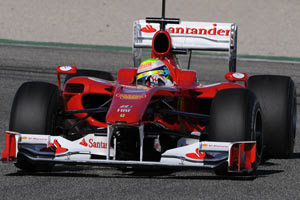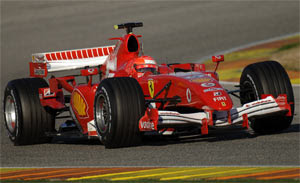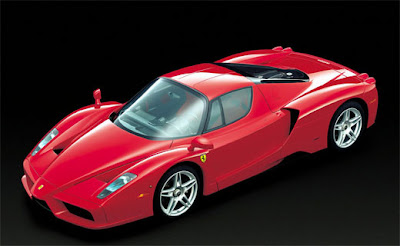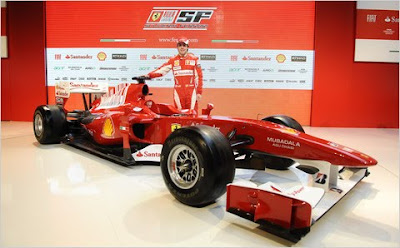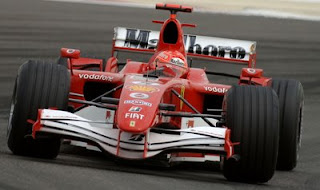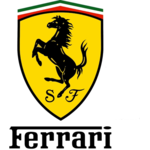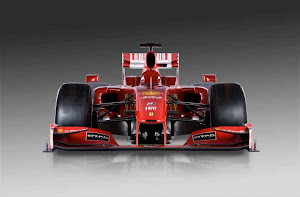- Chassis: Carbon-fibre and honeycomb composite structure
- Gearbox: Ferrari longitudinal gearbox, semiautomatic sequential electronically controlled – quick shift
- Differential: Limited-slip differential
- Number of gears: 7 +Reverse
- Brakes: Brembo ventilated carbon-fibre disc brakes
- Suspension: Independent suspension, push-rod activated torsion springs front and rear
- Weight: with water, lubricant and driver: 620 kg
- Wheels: BBS Wheels (front and rear): 13”
- Engine
- Type: Ferrari 056
- Number of cylinders: V8, 90°
- Cylinder block: In sand cast aluminium
- Number of valves: 32
- Fuel feed: Pneumatic distribution
- Total displacement: 2398 cm3
- Piston bore: 98 mm
- Weight: at least 95 kg
- Injection: Electronic injection and ignition
- Fuel: Shell V-Power
- Lubricant: Shell Helix Ultra
Saturday, February 20, 2010
Ferrari F10 (2010)
Labels: ferrari car, history
Posted by iko at 3:23 PM 0 comments
Ferrari F60 (2009)
The project, which goes by the internal code name of 660, represents the Scuderia's interpretation of the regulations that come into force this year, which include very many new elements. As far as the aerodynamics are concerned, these modifications are the result of the work carried out by the OWG (Overtaking Working Group,) set up by the FIA in collaboration with the teams to produce a set of rules aimed at encouraging more overtaking on track: the front wing, which has a neutral central profile, common to all, is developed mainly on its side elements and is much wider than in the past: the bodywork can no longer carry the slotted apertures that had characterised the Ferrari cars over the past few years.
Other aerodynamic devices are also significantly reduced; the rear wing is higher and narrower than in the past; the diffuser has been moved rearward. The combination of changes naturally led the initial design phase down radically different routes when it came to the side pods and protection components: the apertures have been reduced in size and moved rearward, while the upper and rear elements are larger to aid the exit of air
Specifications
- Chassis: Carbon-fibre and honeycomb composite structure
- Differential: Ferrari longitudinal gearbox, Limited-slip differential
- Gearbox Semiautomatic sequential electronically controlled gearbox - quick shift; 7 gears + Reverse
- Brakes: Brembo ventilated carbon-fibre disc brakes
- Suspension: Independent suspension, push-rod activated torsion springs front and rear
- Weight: (with water, lubricant and driver) 605 kg
- Wheels: BBS Wheels (front and rear) 13"
- Kers: Kinetic energy recovery system by Ferrari in cooperation with Magneti Marelli
- Engine
- Designation: Type 056
- Configuration: Cilinder block in cast aluminium V8 90°
- Number of valves: 32, pneumatically distributed
- Displacement: 2398 cc
- Piston bore: 98 mm
- Weight: > 95 kg
- Injection: Magneti Marelli digital electronic injection
- Ignition: Magneti Marelli static electronic ignition
- Fuel: Shell V-Power ULG-66L/2
- Lubricant: Lubricant Shell
Labels: ferrari car, history
Posted by iko at 2:17 PM 0 comments
Friday, February 19, 2010
Ferrari F2008 (2008)
- Chassis: Carbon-fibre and honeycomb, composite structure
- Differential: Limited-slip differential
- Gearbox: Ferrari longitudinal, Semiautomatic sequential (7 speeds + reverse), electronically controlled gearbox, quick-shift
- Brakes: Ventiled carbon-fibre disc brakes
- Suspension: Independent suspension, push-rod activated torsion springs front and rear
- Weight: (with water, lubricant and driver): 605 kg
- BBS Wheels: (front and rear): 13 in
- Engine
- Designation: Ferrari 056
- Cylinder configuration: V8, 90°
- Cylinder block: Cast aluminium
- Number of valves: 32
- Distribution: Pneumatic distribution
- Total displacement: 2398 cm3
- Piston bore: 98 mm
- Weight: <95>
- Injection: Magneti Marelli digital electronic injection
- Ignition: Magneti Marelli static electronic ignition
- Fuel: Shell V-Power ULG 64
- Lubrcant: Shell SL-1098
Labels: ferrari car, history
Posted by iko at 3:13 PM 0 comments
Ferrari F2007 (2007)
 The F2007 is the fifty third single-seater built by Ferrari specifically to compete in the Formula 1 World Championship. The project, known internally as the 658, represents the Scuderia's interpretation of the technical regulations that apply for 2007, with changes principally concerning safety, through the introduction of more stringent front and rear crash tests and the addition of a composite material structure to provide lateral protection to the sides of the driver. These modifications have led to a significant increase in the weight of the car, in the region of just under ten kilogrammes.
The F2007 is the fifty third single-seater built by Ferrari specifically to compete in the Formula 1 World Championship. The project, known internally as the 658, represents the Scuderia's interpretation of the technical regulations that apply for 2007, with changes principally concerning safety, through the introduction of more stringent front and rear crash tests and the addition of a composite material structure to provide lateral protection to the sides of the driver. These modifications have led to a significant increase in the weight of the car, in the region of just under ten kilogrammes.- Chassis: Carbon fibre and honeycomb composite structure
- Gearbox: Ferrari 7-speed (+reverse) longitudinal gearbox
- Differential & gearbox:Limited slip differential, semiautomatic sequential electronically controlled gearbox
- Brakes: Ventilated carbon fibre disc brakes
- Suspension: Independent suspension, push rod activated torsion springs, front and rear
- Dimensions
- Length: 4545 mm
- Width: 1796 mm
- Height: 959 mm
- Wheelbase: 3135 mm
- Front track: 1470 mm
- Rear track: 1405 mm
- Weight with water, lubricant and driver: 600 kg
- Wheels (front and rear): 13"
- Engine
- Type: 056
- Number of cylinders: 8
- Cylinder block in cast aluminium: V 90°
- Number of valves: 32
- Pneumatic distribution
- Total displacement: 2398 cm3
- Piston bore: 98 mm
- Weight: More than 95 kg
- Ignition: Magneti Marelli digital electronic injection
- Magneti Marelli: static electronic ignition
- Fuel: Shell V-Power ULG 62
- Lubricant: Shell SL-0977
Labels: ferrari car, history, news ferrari F1
Posted by iko at 3:10 PM 0 comments
Thursday, February 18, 2010
Ferrari 248 F1 (2006)
Then came Aldo Costa, creator of the 248 F1, to reflect on Byrne's role and the characteristics of the car in detail. He declared that: "it was mainly to do with the V8 engine and we imposed a radical change from both a mechanical and aerodynamic point of view. The aerodynamics are still at a preliminary stage and will be until the first race of the season. As regards the chassis, this is totally new, above all in the centre section. We decided on this in order to optimise the weight distribution and lighten the entire structure. The same goes for the suspension, especially in the completely redesigned rear end. The transmission too is all new (though constructed from composite materials) and also the differeential. In building these two new elements in particular, we had to pay close attention to the characterisitcs of the V8. The greater vibrations generated by the engine brought more initial problems".
- Chassis: Carbon fibre and honeycomb composite structure
- Gearbox: Ferrari 7-speed (+reverse)
- Differential & gearbox:Limited slip differential, semiautomatic sequential electronically controlled gearbox
- Brakes: Ventilated carbon fibre disc brakes
- Suspension: Independent suspension, push rod activated torsion springs, front and rear
- Dimensions
- Wheelbase: 3050mm
- Front track: 1470mm
- Rear track: 1405mm
- length: 4545mm
- height: 959mm
- width: 1796mm
- weight: 600kg including driver and camera
- Wheels, front and rear: 13"
- Engine: Type 056
- Cylinders: V8 90°
- Cylinder block: Cast aluminium
- Number of valves: 32, pneumatic distribution
- Total displacement: 2398 cm³
- Piston bore: 98 mm
- Weight: 95 kg
- Injection: Magneti Marelli digital
- Iginition: Magneti Marelli static
- Fuel: Shell V-Power ULG 59
- Lubricant: Shell SL-0932
Labels: ferrari car, history
Posted by iko at 3:08 PM 0 comments
Wednesday, February 17, 2010
Ferrari F2004
The chassis is new, both in terms of design and construction. Its weight has been reduced and it has an improved structure when compared with the F2003-GA. The bodywork, exhausts and the rear end have been redesigned, producing an improvement in aerodynamic performance. The front and rear suspension has been revised in order to improve the vehicle's dynamic handling which leads to a greater efficiency in terms of getting the most out of the Bridgestone tyres, while also optimising the performance of the aerodynamic package. New materials have been used in the engine and transmission in order to reduce its size and weight. Modifications to the sporting regulations regarding the number of engines that can be used in the course of a Grand Prix weekend set new targets for the 053 engine design project: achieving the optimum reliability level, even though engine life now has to be double that in the past, while striving to improve performance. Once again the engine is a stressed member and is mounted longitudinally. Shell has played an important role in the research and design of the 053 and in terms of reaching the performance and reliability targets, coming up with new fuel and lubricants.
- Engine: Type 053, V10, cylinder block in cast aluminium
- Total displacement: 2,997 cm3
- Timing gear: Pneumatic distribution, 40 valves
- Fuel feed: Magneti Marelli digital
- Ignition: Magneti Marelli static
- Transmission: Ferrari longitudinal gearbox. Limited-slip differential. Semiautomatic sequential electronically controlled gearbox, 7 gears + riverse
- Chassis: Carbon-fibre and honeycomb composite structure
- Suspension: Independent suspension, push-rod activated torsion springs front and rear
- Brakes: Ventilated carbon-fibre disc brakes
- Weight with water, lubricant and driver: 605 kg
- Wheels: (front and rear) 13”
- Dimensions:
- Length: 4545 mm
- Width: 1796 mm
- Height: 959 mm
- Wheelbase: 3050 mm
- Front track: 1470 mm
- Rear track: 1405 mm
Labels: ferrari car, history, news ferrari F1
Posted by iko at 2:59 PM 0 comments
Ferrari F2005 (2005)
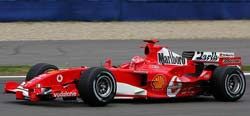 The F2005 is the fifty first single-seater built by Ferrari specifically to compete in the Formula 1 World Championship. The design, which bears the internal code number 656, represents Ferrari's more exhaustive interpretation of the 2005 technical regulations. The main elements, relating to aerodynamics are more advanced than on the F2004 M.
The F2005 is the fifty first single-seater built by Ferrari specifically to compete in the Formula 1 World Championship. The design, which bears the internal code number 656, represents Ferrari's more exhaustive interpretation of the 2005 technical regulations. The main elements, relating to aerodynamics are more advanced than on the F2004 M.- Chassis: Carbon-fibre and honeycomb composite structure
- Gearbox: Semi-automatic sequential electronically controlled gearbox 7 gears + reverse
- Brakes: Ventilated carbon-fibre disc brakes
- Suspension: Independent suspension, push-rod activated torsion springs front and rear
- Length: 4545 mm
- Width: 1796 mm
- Height: 959 mm
- Wheelbase: 3050 mm
- Front track: 1470 mm
- Rear track: 1405 mm
- Weight: with water, lubricant and driver 605 kg
- Wheels: (front and rear) 13”
- Engine: Type 055
- Cylinders: 90° V10
- Cilinder block: Cast aluminium
- Valves: 40 (4 per cylinder), pneumatically distributed
- Total displacement: 2997 cm3
- Injection: Magneti Marelli digital
- Ignition: Magneti Marelli static
Labels: ferrari car, history
Posted by iko at 1:03 PM 0 comments
Tuesday, February 16, 2010
Ferrari F2003-GA
- Chassis: carbon fibre and honeycomb composite structure
- Transmission: 7-speed
- Suspension: independent, pushrod activated torsion springs front and rear
- Overall length: 4545mm
- Width: 1796mm
- Height: 959mm
- Wheelbase: 3100mm
- Front track: 1470mm
- Rear track: 1405mm
- Tyres: Bridgestone Potenza
- Engine: Ferrari 052 90° V10
- Total displacement: 2997cc
- Estimated power: 920bhp @ 18600rpm
- Valves: 40, pneumatic distribution
- Electronics and ignition: Magneti Marelli
Labels: f1, ferrari car, history
Posted by iko at 2:55 PM 0 comments
Ferrari F2002 (2002)
- Chassis identification: Ferrari F2002
- Construction: Carbon-fibre and honeycomb composite structure
- Front suspension: Independent suspension, push-rod activated torsion springs
- Rear suspension: Independent suspension, push-rod activated torsion springs
- Wheels: 13" BBS
- Tyres: Bridgestone
- Brake discs/pads: Ventilated carbon-fibre disc brakes
- Gearbox: Semiautomatic sequential electronically controlled gearbox, limited-slip differential, 7 gears + reverse
- Dimensions:
- Length: 4.495 mm
- Width: 1.796 mm
- Height: 959 mm
- Front Track: 1.470 mm
- Rear Track: 1.405 mm
- Engine name: Ferrari type 051
- Displacement: 3 litres
- Configuration: 90° V10, naturally aspirated
- Fuel feed: Magneti Marelli digital
- Ignition: Magneti Marelli static
- Valve train: 4 valves per cylinder; pneumatic valve system
Labels: f1, ferrari car, history
Posted by iko at 2:41 PM 0 comments
Sunday, February 14, 2010
Enzo Ferrari
The founder for Ferrari is Enzo Ferrari. Born on the 18th February 1898 in Modena, Italy, Ezno did not have a very formal education because he was not particularly interested in his studies. He was very determined in racing cars. He took up racing when he was 19 but did not have huge success.

He then left the tracks and secured a job at Alfa Romeo. He took the job as a car racer with them and found bigger success than he did previously. After racing for Alfa Romeo for more or less 20 years, he left the company to set up his own company, the Auto-Avio Construzini to subsequently build his own racing cars under his own name, Ferrari. The rest as they say is history.
The Enzo Ferrari was the Ferrari that was named exactly after its owner. This Ferrari was built in the year 2003 and it was built using some of the Formula 1 technologies. These technologies include F1-style carbon-ceramic brake discs, carbon-fiber body, and sequential shift transmission. To build a car with the best performance, the designers of this Enzo Ferrari also went as far as to use banned Formula 1 technology which is the active and integrated aerodynamics.
The Enzo Ferrari has the largest engine as compared with the other Ferraris. Despite that fact, the Enzio Ferrari was made with inspirations from the racing tracks. With this reason, the frame of Enzio Ferrari was made out of carbon fiber and aluminum honeycomb panels.
This frame will then form a rigid tub for the Enzo Ferrari. In the middle of the frame is where the new large engine F140 is at. The all new F140 is actually a twelve cylinder engine. This particularly large engine is attached to the alloy sub-frame at two points. The purpose of this design is to prevent the vibrations from escaping into the passenger compartment.
As mentioned about the inspirations from the Formula 1, this Enzo Ferrari uses an electro hydraulic system that automatically activates the clutch and the gear changes. This is actually a semi-automatic gearbox and it helps the driver of the Enzo Ferrari to change their gears in 150 milliseconds. The driver may also achieve gear changes in 90 milliseconds if he is driving the Enzo Ferrari in sport mode.
The uniqueness of this Enzo Ferrari also lies with the embedded electronic system that they used on the sport car. These embedded electronic systems are included to ensure the comfort of the driver while driving the Enzo Ferrari. The designers included a central computer that can synchronize the engine, the suspension, and the transmissions. Inside the Enzo Ferrari, the designers also included the aerodynamic subsystem to optimize the performance and also the wellbeing of the driver.
Like the founder of the Ferrari, the Enzo Ferrari is truly a unique car of its own. There are those that are similar but they can never compete with the quality and the performance of the Enzo Ferrari. It is no wonder why people still want to own a Ferrari to this day.
Labels: ferrari car
Posted by iko at 6:38 PM 0 comments
Sunday, February 7, 2010
F1 Scuderia Ferrari Marlboro Unveiled
The 2010 Scuderia Ferrari Marlboro will run in the upcoming Gulf Air Bahrain Grand Prix, which is the first race of the 19-race Formula 1 2010 season. The first racing weekend of the new season is March 12-14. The events/races are three-day affairs held on weekends. Season ends in Dubai at Yas Marina Circuit at Ethiard Airways Abu Dhabi Grand Prix the weekend of November 12-14.
Meanwhile, back at the Ferrari stable, the Marnello’s broadcast also will present interviews of pro drivers, providing their behind-the-wheel perspective on Ferrari’s latest one-seat F1 entry.
Pit stop: F-1’s second race is two later in Melbourne; the destinations for these events are as intriguing as the races are exciting. No offense, Indianapolis, but Istanbul, Sao Paulo, Dubai, and Monte Carlo...now 19 exotic luxury destinations! Check out the schedule. Show it to your wife.
Labels: news ferrari F1
Posted by iko at 2:49 PM 0 comments
Saturday, February 6, 2010
Ferrari Introduces F1 Car Online
Ferrari became the first team to introduce its new car today — after Mercedes introduced its new colors on the old Brawn car earlier in the week — and the teams seem already to be jockeying for position. Ferrari has stated that the new car has set a record: the connections to the ferrari.com Web site.
“More than three million users were connected to watch the presentation, which let the Web site freeze for a couple of seconds in several moments,” the team said in a statement.
Hmm, not being in Italy for this, I was one of those million connections. And I did wonder about that “couple of seconds” that just kept on repeating themselves. But I didn’t care. That was a great way to see the introduction and to hear Luca di Montezemolo, the chairman of Ferrari.
Labels: f1, news ferrari F1
Posted by iko at 6:29 PM 0 comments
Friday, February 5, 2010
VALLES SET FOR SECOND US F1 SEAT

US F1 are poised to appoint Adrian Valles as their second driver ahead of their debut campaign in Formula One.
The Charlotte-based team, who recently signed Argentinean Jose Maria Lopez, look set to confirm Valles next week.
The 23-year-old Spaniard from Alicante, who was previously a test driver with Spyker in 2007, won last year's Superleague Formula title with Liverpool
Speaking to local media, a coy Valles said: "I'm sorry, I can't talk. I just hope things don't go wrong."
Should US F1 sign Valles, he will be the fourth Spaniard on the grid for 2010 along with Fernando Alonso at Ferrari, Pedro de la Rosa of Sauber and Toro Rosso's Jaime Alguersuari.
Labels: f1, news ferrari F1
Posted by iko at 2:32 PM 0 comments
Double F1 world champion Alonso lays down Ferrari marker
VALENCIA, Spain — Double world champion Fernando Alonso set a scorching pace in Formula One testing here on Wednesday, laying down an early marker to Michael Schumacher and title holder Jenson Button.
Watched by over 35,000 passionate home fans, Alonso clocked a best of 1min 11.470sec after putting in 127 laps in his first full outing for his new Ferrari team.
Schumacher, in his Mercedes, was third fastest with a best of 1min 12.438sec, just behind Sauber's Pedro de la Rosa in 1min 12.094sec.
"It was a very emotional day, very special because it's also my father's birthday. These past few days I have been really anxious to get into the car," said Alonso, who also praised the crowd.
"We expected a lot of people. But it's one thing to expect, it's another to see them there in the stands. Each time I went onto the track I could see how excited they were."
Despite being half a second faster than his rivals, Alonso urged against over-optimism in the knowledge that early-season test times are traditionally an unreliable guide to the season ahead.
Many teams opt to concentrate on set-ups, fuel loads and gaining crucial technical data as opposed to setting the fastest time.
"You don't have to set great times. You can drive with more or less fuel, use more or fewer tyres. I'm happy to be in the car, but I remain cautious," said the Spaniard.
Alonso, who has moved to Ferrari from Renault, will also test at Jerez from February 10 with the 2010 world championship due to start in Bahrain on March 14.
Meanwhile, seven-time world champion Schumacher admitted his high-profile return to Formula One after a three-year absence has been easier than he thought.
"Actually it's been much easier than I anticipated. I thought it would need a bit more time but it went pretty quickly," said 41-year-old Schumacher who drove 82 laps on Wednesday.
"I'm really happy. I had a good first day, with a rather short run (40 laps) on Monday. Today we had a full day. A little hydraulic leak has stopped us.
"But all in all, it's very positive feedback. The car is running very smoothly, very nicely. I'm very positive."
Testing continues in Jerez in Spain next week and Schumacher will again take track time.
World champion Button, who has moved to McLaren from Brawn GP, drove his new car for the first time on Wednesday, but spent a large part of the morning in the pits working on his seat position.
Button, who will partner 2008 world champion Lewis Hamilton at McLaren, was eventaully fifth fastest on the day with a best time of 1min 12.951sec.
"This is the wrong place for us to be thinking about who is quick and who isn't," he said.
"I'm guessing everyone is going to be having updates for the first race anyway and with the difference in fuel loads, you could be running 10 kilos or 160 kilos, so there is a massive difference."
Jaime Alguersuari, in a Toro Rosso, was fourth fastest in 1min 12.576sec, with Vitaly Petrov, the first Russian driver in F1, clocking 1.13.097 in a Renault.
Williams' Nico Hulkenberg was seventh quickest in 1min 13.669sec.
Labels: news ferrari F1
Posted by iko at 2:22 PM 0 comments
Ferrari F10 dominates Valencia tests
The fact that Alonso's lap time was not merely a one-off occurence, but consistent over the course of the day, could very well be a sign of Ferrari's return to form.
Pedro de la Rosa continued to surprise onlookers as he piloted the BMW Sauber C29 to a fine second place on the timing sheets, outpacing seemingly stronger rivals. While there is still speculation as to whether or not the Spaniard was running light on fuel, he still managed to be consistently quick, setting a best lap time of 1m 12.094 secs.
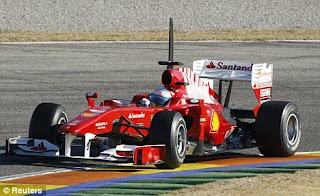 Michael Schumacher, running in the Mercedes GP W01 managed a time of 1m 12.438 secs, almost a full second slower than that of Fernando Alonso. The W01 is yet to have its final 2010 diffuser and front wing fitted on to the car. Michael's run was cut short prematurely by a hydraulic problem on the car.
Michael Schumacher, running in the Mercedes GP W01 managed a time of 1m 12.438 secs, almost a full second slower than that of Fernando Alonso. The W01 is yet to have its final 2010 diffuser and front wing fitted on to the car. Michael's run was cut short prematurely by a hydraulic problem on the car.
While Ross Brawn has stated that the Mercedes GP team isn't where it had hoped to be, Schumacher has also said that he doesn't believe the team can win races from the very beginning of the season.
Labels: f1, news ferrari F1
Posted by iko at 2:10 PM 0 comments
